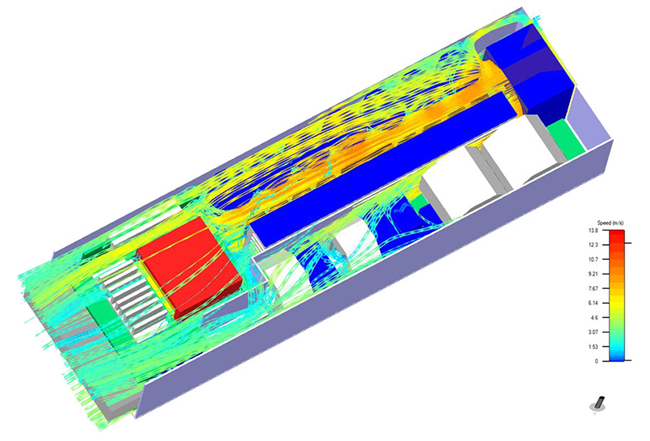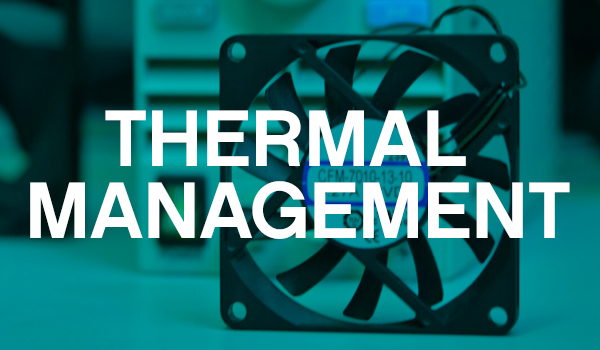What is Computational Fluid Dynamics?

When working with heat transfer and cooling of any product or system, guesswork and hope are not options while trial and error is an expensive and inefficient method. By treating heat as a fluid, there is a way to model the movement of heat in a precise and true-to-life manner. Computational Fluid Dynamics (CFD) is a powerful analytical tool that empowers project teams to explore and evaluate solutions to engineering problems, mitigating risks before committing real-world resources.
By utilizing numerical algorithms, CFD solves complex non-linear partial differential equations governing fluid mechanics and heat transfer. This approach enables the creation of three-dimensional models that accurately represent spatial and temporal aspects of physical systems, yielding highly realistic solutions without the expenses associated with experimental analyses.
When computational fluid dynamics is employed for thermal analysis, it enables the calculation of heat transfer between a fluid and a solid and the evaluation of convection within the surrounding fluid. Numerical algorithms are employed in CFD to simulate three-dimensional (3-D) fluid motion and heat transfer, facilitating thermal analysis. CFD thermal analysis effectively incorporates the impacts of heat transfer methods, including conduction, convection, and radiation, into fluid flow simulations, resulting in realistic and comprehensive outcomes. Check out other blog posts from our thermal simulation with computational fluid dynamics (CFD) series below:
- How to Conduct a Thermal Simulation with CFD
- CFD Thermal Simulation Best Practices
- The Future of Thermal Simulation with CFD
While most computational fluid dynamics software is general and used for modeling both heat but also airflow, phase change, and more, there is specific CFD software available both for heat transfer in general and, more specifically, heat flow within electronics devices. By focusing on a more particular niche, this software simplifies the setup and solution as there are less options to deal with. For instance, certain software has specifically built-in features to accurately model integrated circuit packages, circuit boards, heat sinks, heat pipes, fans, and more. As an example, this software can find the operating point of a fan based on the system resistance it calculates, ensuring the right balance of airflow to adequately cool the devices without being wasteful.

Through CFD thermal analysis simulations, other valuable information can also be extracted, enabling accurate predictions of various factors, including:
- Airflow fields and patterns
- Heat flux rates
- Hot spots
- Temperature distribution
- Heat transfer rates
Designers can leverage this data to develop effective thermal management solutions and ensure the reliability and safety of their designs. With insights into these vital thermal parameters, designers can make informed decisions to optimize heat dissipation, improve cooling strategies, and prevent thermal issues that could compromise the performance or longevity of the system.
How Does Computational Fluid Dynamics Work?
Computational fluid dynamics is based on three fundamental physics equations - the conservation of mass, conservation of momentum, and conservation of energy. These are also referred to as the Navier-Stokes equations and, if the model is set up correctly based on these equations and the model converges on a solution, it confirms that the model satisfies the laws of physics and that the results can be trusted.
In a standard CFD analysis, three primary processes are typically followed. However, it is worth considering additional activities that may occur before and after these main processes to provide a comprehensive understanding.

The Phase of Mathematical Modeling
Before conducting a CFD analysis, the problem must already exist as a partial differential problem. This initial phase is essential as it precedes the CFD analysis and lays the groundwork for the subsequent steps.
Pre-Processing Stage
During the pre-processing stage, the CFD software transforms the partial differential equation into a set of algebraic equations. This stage also involves the crucial process of mesh generation, where the model is fragmented into structured or unstructured elements, such as triangles or quadrilaterals. Additionally, the size of the mesh elements in the flow field is refined using the finite element method, ensuring accurate representation and effective analysis of the system.
Solving Stage Using CFD Simulation Software
In the solving phase, CFD simulation software is employed to solve the mathematical equations formulated in the pre-processing phase. Computation time for CFD flow simulations can vary depending on factors such as:
- computer hardware
- vectorization, parallelization
- data structures
- stopping criteria
- mesh size, mesh quality, time
- the programming language used
In addition to the factors above, engineers and designers have the flexibility to consider various other variables and parameters that can influence the CFD analysis.
Post-Processing Stage
The post-processing stage involves extracting and interpreting data from the simulation. At this stage, the analyst concludes the need for further tests, optimization, or redesign based on the findings. The results can be presented using images, graphs, and tables, facilitating effective communication of the analysis outcomes.
Utilizing Outcomes to Optimize Heat Transfer and Cooling Efficiency
After going through the entire process of a CFD thermal analysis, engineers and designers are given the information they need to make overarching changes to the design. This analysis enables the determination of heat transfer properties in product designs across all three fundamental heat transfer processes: conduction, convection, and radiation. By leveraging CFD, engineers can obtain precise solutions that enhance aerodynamic performance while optimizing fluid flow and heat transfer. The outcomes derived from CFD analysis are valuable in identifying deficiencies in existing heat transfer and cooling systems within current designs, enabling engineers to implement improvements. This comprehensive approach allows engineers to fine-tune the thermal management strategies, ensuring efficient heat dissipation, enhanced cooling performance, and improved overall system reliability.
Addressing Thermal Hotspots in Product Design
CFD simulations offer enhanced precision and comprehensive insights compared to physical experiments, particularly when dealing with intricate flow systems that pose challenges in detecting thermal hotspots. These hotspots represent localized regions with higher temperatures than their surroundings. Neglecting the mitigation of these hotspots can result in the continuous accumulation of heat, potentially leading to severe consequences such as system failure, malfunction, or damage to the product. Such outcomes not only endanger the lifespan of the electronic product but also pose risks to the safety of its users.
By utilizing CFD thermal simulations, valuable insights into thermal distribution can be obtained, enabling the identification of potential thermal hotspots within a product design. Once these specific areas are identified, targeted improvements can be made to enhance heat transfer designs, effectively mitigating the risk of heat accumulation in those regions. Consequently, the optimized system is less prone to damage and can have an extended service life.
Achieving Cost and Time Savings through Virtual Testing and Optimization
Engineers constantly strive to develop improved electronic products, but final approval for mass production often hinges on real-world test results. The design process for modern electronic products is typically intricate and compact, requiring substantial investments of time and money to produce a single prototype. Once the prototype is completed, it undergoes thermal strain tests to assess its durability, physical attributes, and suitability for real-world applications. Successful completion of these tests approves mass production. However, in the event of prototype failure, the investment becomes a total loss.
CFD offers the capability to simulate real-world environments and test virtual models of electronic products. Using CFD, heat transfer analysis can be performed on the design, identifying potential errors and providing opportunities to refine and rebuild the model for further analysis. The results obtained from CFD simulations are highly precise, providing engineers with a visual representation of flow patterns and enabling a comprehensive understanding of complex flow systems that exceeds what can be achieved through physical experiments. This iterative process eliminates the need for physical prototypes and reduces the risks associated with significant time and cost investments, enabling researchers to create an optimized product suitable for mass manufacturing.
Summary
Computational fluid dynamics is a powerful tool that quantifies and predicts the movement of heat, allowing quick and inexpensive iterations through a design. While the upfront work and costs may cause some small businesses to hesitate to put forth the resources to create the models and set up the simulations, the long-term benefits almost always make it worth it. Updating the model and simulation to perform multiple iterations and quickly compare dozens, if not hundreds, of different configurations is comparatively easy. A good understanding of the underlying principles on how this science and software work helps any user to know the expectations and limitations of this science and its implementation. With the appropriate software and high-quality models, electronics and electrical engineers can create the ideal solution seeking to keep their designs cool. If you have any questions, Same Sky’s thermal design services and range of thermal management components are here to help.






